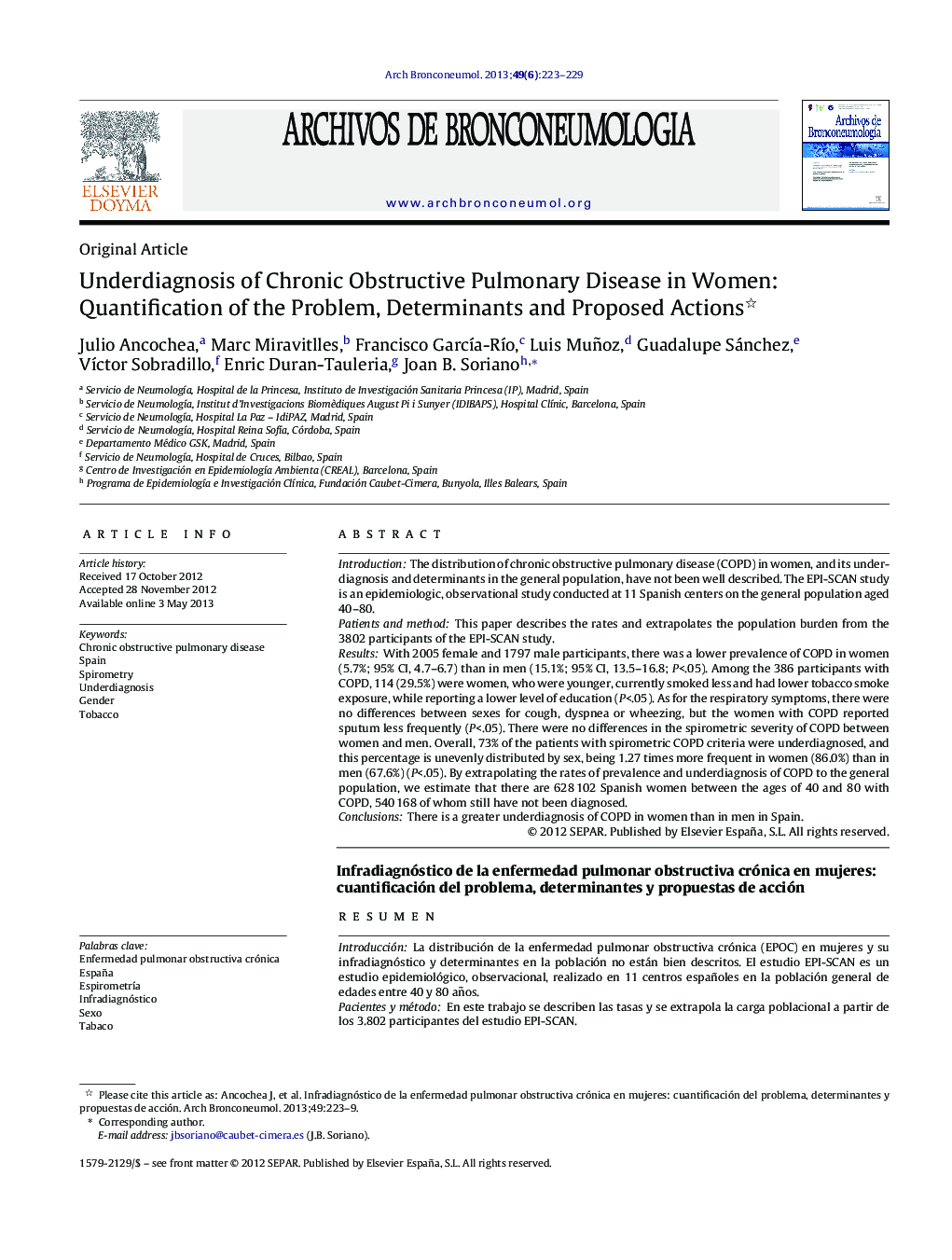| Article ID | Journal | Published Year | Pages | File Type |
|---|---|---|---|---|
| 4205669 | Archivos de Bronconeumología (English Edition) | 2013 | 7 Pages |
IntroductionThe distribution of chronic obstructive pulmonary disease (COPD) in women, and its underdiagnosis and determinants in the general population, have not been well described. The EPI-SCAN study is an epidemiologic, observational study conducted at 11 Spanish centers on the general population aged 40–80.Patients and methodThis paper describes the rates and extrapolates the population burden from the 3802 participants of the EPI-SCAN study.ResultsWith 2005 female and 1797 male participants, there was a lower prevalence of COPD in women (5.7%; 95% CI, 4.7–6.7) than in men (15.1%; 95% CI, 13.5–16.8; P<.05). Among the 386 participants with COPD, 114 (29.5%) were women, who were younger, currently smoked less and had lower tobacco smoke exposure, while reporting a lower level of education (P<.05). As for the respiratory symptoms, there were no differences between sexes for cough, dyspnea or wheezing, but the women with COPD reported sputum less frequently (P<.05). There were no differences in the spirometric severity of COPD between women and men. Overall, 73% of the patients with spirometric COPD criteria were underdiagnosed, and this percentage is unevenly distributed by sex, being 1.27 times more frequent in women (86.0%) than in men (67.6%) (P<.05). By extrapolating the rates of prevalence and underdiagnosis of COPD to the general population, we estimate that there are 628 102 Spanish women between the ages of 40 and 80 with COPD, 540 168 of whom still have not been diagnosed.ConclusionsThere is a greater underdiagnosis of COPD in women than in men in Spain.
ResumenIntroducciónLa distribución de la enfermedad pulmonar obstructiva crónica (EPOC) en mujeres y su infradiagnóstico y determinantes en la población no están bien descritos. El estudio EPI-SCAN es un estudio epidemiológico, observacional, realizado en 11 centros españoles en la población general de edades entre 40 y 80 años.Pacientes y métodoEn este trabajo se describen las tasas y se extrapola la carga poblacional a partir de los 3.802 participantes del estudio EPI-SCAN.ResultadosCon 2.005 mujeres y 1.797 hombres participantes, se obtuvo una prevalencia de EPOC inferior en mujeres (5,7%; IC 95%, 4,7–6,7) que en hombres (15,1%; IC 95%, 13,5-16,8; p < 0,05). Entre los 386 participantes con EPOC, las 114 (29,5%) mujeres eran más jóvenes, menos fumadoras actualmente y tenían menor exposición tabáquica, y referían menos nivel de estudios (p < 0,05). Respecto a los síntomas respiratorios, no existían diferencias por sexo en tos, disnea o sibilantes, pero las mujeres con EPOC referían esputo menos frecuentemente (p < 0,05). No existían diferencias en la gravedad espirométrica de la EPOC entre mujeres y hombres. El 73% de los pacientes con criterios de EPOC fueron infradiagnosticados, y este porcentaje se distribuye desigualmente por sexo, siendo 1,27 veces más frecuente en mujeres (86,0%) que en hombres (67,6%) (p < 0,05). Extrapolando las tasas de prevalencia e infradiagnóstico de EPOC a la población, se estima que en España entre las mujeres con edades comprendidas entre 40 y 80 años existirían 628.102 mujeres con EPOC, de las cuales 540.168 aún estarían sin diagnosticar.ConclusionesLa EPOC está más infradiagnosticada en mujeres que en hombres en España.
